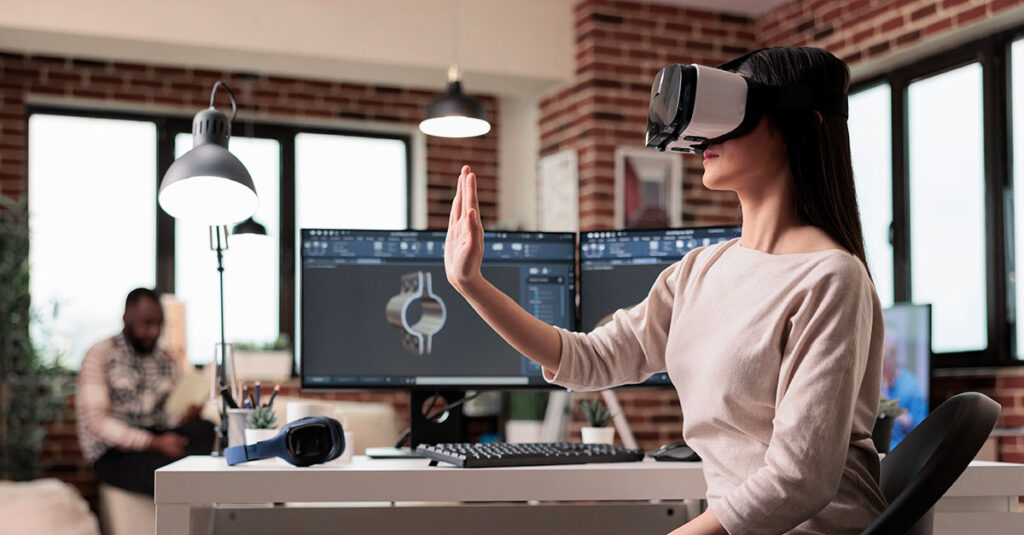
What’s the Difference Between MR, AR and VR?
Virtuality reality, augmented reality and mixed reality are three related concepts that all rely on similar technologies. In fact, you can think of them as different points on the continuum between the physical world and a fully digital space. Virtual reality is the sci-fi idea of putting on a headset and entering a completely virtual world that doesn’t overlap with reality, while augmented reality and mixed reality both involve overlaying the real world with digital elements. If that sounds confusing, don’t worry, I’ll explain everything as we go.
One last thing before we dig in. Virtual reality (VR), augmented reality (AR) and mixed reality (MR) are sometimes all grouped together under the term “extended reality,” or XR. While it hasn’t fully caught on yet, it’s a handy catchall term for the next generation of technologies that combine the physical world with some kind of digital overlay.
Now, let’s break things down a little more and look at the difference between VR, AR and MR.
What is virtual reality?
VR is the most sci-fi concept of the three, though perhaps the least practical. It uses a headset to create a fully immersive and simulated virtual experience. You should feel like you’re in whatever virtual world is being displayed.
Because it’s so immersive, VR is often used for VR video games like “Beat Saber” or “Resident Evil 4,” though you can also watch some VR videos on YouTube. There are a few ways to use VR professionally as well, but they aren’t super widespread yet.
What is augmented reality?
AR is where digital elements are overlaid on the physical world. My favorite example is the Rekkie Smart Snow Goggles. When you’re skiing or snowboarding, they have a heads-up display that shows things like your current speed, your compass heading and even how far away and in which direction your friends are.
But AR is also popping up in other places, and, crucially, it doesn’t require a headset. The IKEA smartphone app can show you how different pieces of furniture will look in your home. And there are plenty of entertaining uses, too: Instagram’s and Snapchat’s face-changing filters are essentially AR, and there are even AR games like “Pokémon Go.”
Overall, AR is probably going to be the most popular form of extended reality over the next few years because it’s so much more accessible. All you need is a smartphone.
What is mixed reality?
MR falls between AR with its digital overlay on top of the real world and VR with its fully immersive simulation. While it’s a broad definition, MR enables virtual and real objects to interact and exist with equal importance.
This will make more sense once you understand how MR works. The latest XR headsets, like the awesome Meta Quest 3 and the just-released Apple Vision Pro, use a combination of screens, cameras and sensors to create an immersive MR experience. The cameras and sensors capture your real life environment and then let you view it, along with any virtual elements, on the screen in front of your eyes. Because the cameras and sensors are also able to track your hands, you can often “touch” virtual elements and manipulate them directly. For example, both the Quest 3 and Vision Pro offer a virtual keyboard you can type on and also display virtual screens with different apps hovering in front of your eyes.
Of course, the price tag of a feature-packed headset is a bit of a barrier to entry for most people. Over the next few years, MR is likely to be most popular with large companies that can use it to train staff, provide tele-support to workers in the field and otherwise justify the cost associated with it.
How do I try AR, VR and MR?
If you’ve got a smartphone, you can try AR right now. There are plenty of AR games worth checking out, with “Pokémon Go” as the most well known. You can also try AR shopping through Amazon, IKEA or any of the other apps that support it.
To make the most of VR, you need a VR headset. Here’s a guide to choosing the right VR headset for you. The Sony PlayStation VR2 is a great option if you have a PlayStation 5. Otherwise, any of Meta’s Quest headsets is a good place to start. The best way to really experience VR is to play an immersive game. My favorite is “Beat Saber” which is available on almost every platform.
If you want to experience MR, you’ll also need a VR headset. The most affordable headset that offers a solid MR experience is the Quest 3, which starts at $500. After that, you’re looking at very expensive gear like the Microsoft Hololens 2 ($3,500) or the Apple Vision Pro ($3,500). It is the future, but it will be a few years before it’s affordable for most people.
Of course, there’s one other thing you need if you want to try AR, VR and MR: a fast, stable internet connection. If you’re going to collaborate with other people in MR or VR, or just want to download VR or AR games quickly, you need a great internet service like gigabit fiber.
Experience a future of wins with Frontier Fiber
When you’re uploading and downloading to play, give yourself the fiber advantage. Frontier Fiber was rated #1 internet service provider for online gaming in the country, according to U.S. News & World Report. Ready, set, Frontier Fiber! Frontier Fiber is available in select areas—check here to see when it’s available at your address.
Product features and availability may have changed and are subject to change.




Join the conversation